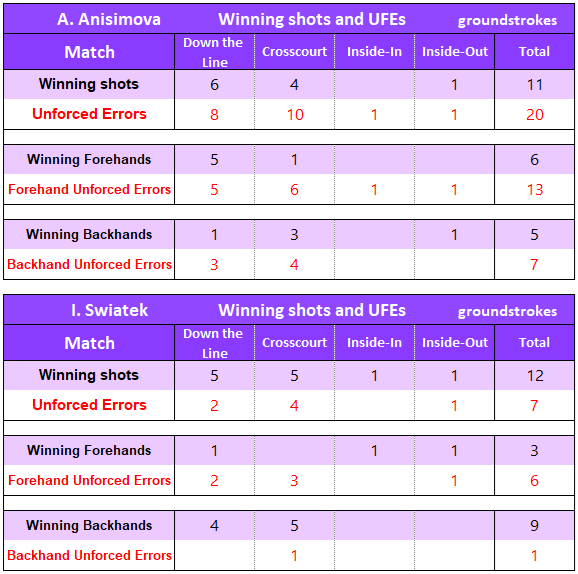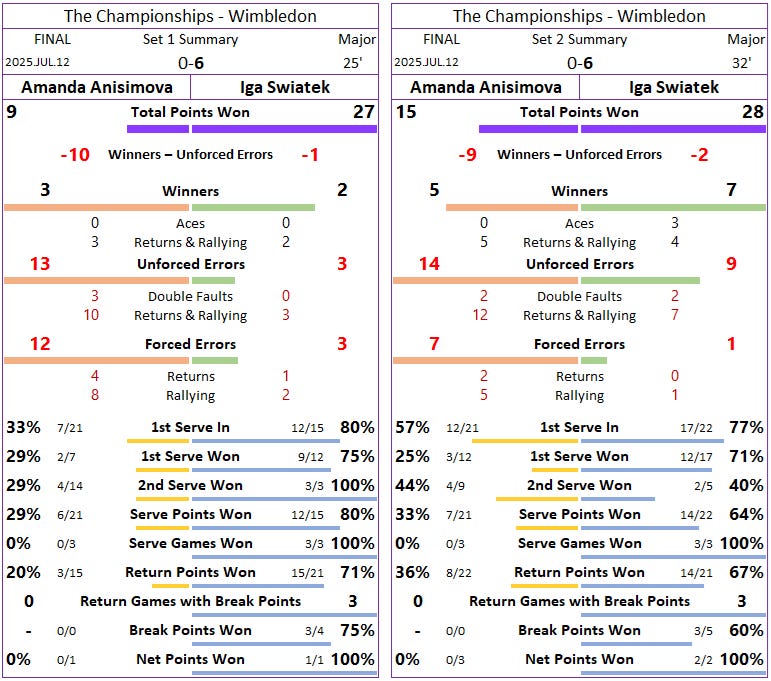Wimbledon: Amanda Anisimova vs Iga Swiatek final analysis
Crucial micro-moments of a final no one predicted
Surprise, surprise, Iga Swiatek conquered the grass and is now a Wimbledon champion!
The 24-year old Pole smashed her own beliefs and Amanda Anisimova’s hopes for a dream Grand Slam final debut with a stunning 6-0, 6-0 win in 57 minutes to clinch her sixth Major title and become an all-surface winner.

This was only the third time, second in Open era, a Grand Slam championship match ended with a double bagel score. Dorothea Lambert Chambers was the first one to do it in 1911 against Dora Boothby at Wimbledon, then Steffi Graf famously dispatched Natasha Zvereva in 34 minutes at the 1988 French Open.
Ironically, Anisimova had started her 2025 Wimbledon campaign with a 6-0, 6-0 triumph over Yulia Putintseva… the last player to defeat Swiatek at SW19.
The 23-year old American was playing in the biggest match of her career thus far, so nerves were expected at the start of the final. Something that made the first few games very tricky and Swiatek the worst possible matchup.
The former #1 can look too human at times on a tennis court when she is stressed and anxious, like in the already mentioned frustrating Wimbledon defeat to Putintseva last year.
But when Swiatek senses tension on the other side of the net, she just preys on opponents in a ruthlessly, robotic-like manner. Hence the “bakery server” and “frontrunner of frontrunners” fame!
This season, amid the underachieving criticisms, Swiatek had still won 35 of 36 matches after taking the first set. Anisimova entered the Wimbledon final not very far behind with a 29-2 record that included a retirement loss right after conceding the second set. But to be in contention at the end of the opening set on Saturday, she first needed to shake off the inevitable nerves.
Anisimova’s tightness was evident when she overhit her first groundstroke of the match…
… and netted a routine “serve+1” forehand in the third point.
Before and after that miss, Swiatek made a statement by ripping a pair of deep, forceful returns. She grabbed an opening break with the last one.
The Pole made sure Anisimova continued to feel the early pressure by not missing a shot in the first 8 points of the match.
There was finally some hope for the maiden Major finalist when she accrued 4 game points during the 3rd game. One was wasted with a poor forehand mistake; the other 3 were quickly and mercilessly erased by Swiatek with quality backhands.
So solid off that wing, Swiatek would finish the Wimbledon final with just 3 missed backhands out of 63 shots from that side.

Instead of getting on the scoreboard and into the match after the 3rd game, Anisimova got trapped in a vicious cycle.
No freebies from her increasingly confident and ruthless opponent meant she had to come up with winners to get a game and release the tension. But quality shots are a lot tougher to deliver when tight and the challenge only worsens as games go by!
After losing the last 11 points of the opener and in shock of what she had experienced, Anisimova looked to reset in the second set.
Her serving struggles continued until the end of the match however, so free points off the serve were not an option. Anisimova made just 19 of 42 (45%) 1st serves during the Wimbledon final and some of those only landed after she deliberately dropped speed by 5%-10%. Swiatek gave nothing away, returned into court all 19 1st serves faced and went on to win 14 (74%) of those points.
In need of an improvement and aware of her early-rally opening set woes, Anisimova tried to extend points and play as conservatively as possible for a power player like her without losing identity. She engaged preferentially in crosscourt exchanges that minimized her movement disadvantage until it was time to pull the trigger down the line.
These tactics led to a 2-shot increase in average rally length of points contested behind her serve during the second set, from 2.67 to 4.62 valid shots per point.
In line with Anisimova’s renewed intentions, the second set kicked off with a 12-shot rally. Unfortunately for her, it was bossed by Swiatek’s backhand.
The Pole moved a set and early break up when Anisimova steered a forehand to the doubles alley while seeking the kill line shot in another long rally.
Points were now longer and games a bit more competitive.
Each of the first 4 games of the second set featured a 30/30 point, with a pair reaching multiple Deuces. It was on those moments that Swiatek exerted her dominance and made sure Anisimova remained under water.
During the second set, Swiatek won all 8 points played with the score at 30/30 or Deuce. Anisimova was unable to create a single game/break point in the set despite being a point away 9 different times (also led 15/30 once).
So Swiatek continued to rack up games and inch closer and closer to a historic victory.
On the last game, she showed off once again one of the biggest factors in her Wimbledon title run.
It was a British fortnight filled with outstanding serving from the Pole:
179 KMH / 111 MPH average 1st serve speed
63% 1st serves landed (245/388)
78% 1st serves won (190/245)
91% serve games won (58/64)
4 of 7 matches without losing serve
Adequate percentage of 1st serves landed, faster deliveries, spots hit on a more consistent basis and a lot of comfortable holds. A winning combination perfectly complemented with a slightly deeper return position that also brought huge dividends.
Swiatek concluded her successful 2025 bid for the Venus Rosewater Dish with an utterly ridiculous 20-game sequence that began in the first set of the semifinal against Belinda Bencic!
Will we witness such outrageous ending to a Grand Slam tournament ever again?!
For the record, here’s how Swiatek clinched a maiden Wimbledon win. A backhand winner in the last and longest rally of the championship match.
Amanda Anisimova (WTA #13, seed 13) vs Iga Swiatek (WTA #8, seed 8)
2025 Wimbledon final - Match Data
Set by Set Stats
Strategy Stats
Points Won by Rally Length
Rally Length
Winners and Errors
Direction of winning shots and unforced errors (only groundstrokes)

Serve Stats
1st Serves
2nd Serves
Return & rallying performance



Points won breakdown
This final section gives a last, broader look at the match by presenting how each player won points. Points are listed according to their frequency (highest to lowest) and are named in relation to the last touch on the ball. For simplicity, groundstrokes hit from the 5th shot onwards are grouped together.
Breakdown by side (FHs or BHs)

Breakdown by error type (UFEs or FEs)

To find out more about the stats published here, please visit the following post.
While we follow the same criteria used on all major tennis events, our stats are collected through our own video analysis and are not official WTA or ITF stats.
Thanks for reading!
— Tennis Inside Numbers














